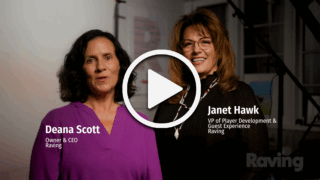
How to drive your casino customers through the door in 2016
So you use all the traditional media to talk to your gamer. You run radio, TV, and send out tons of direct mail. Seems like it’s working. But … are you missing a major channel? If you are not talking to your gamer with all of the digital tools available, you are missing prime opportunities to reach them where they are spending a significant amount of time.
Digital marketing is essential for today’s businesses looking to reach their target market in order to build awareness and drive customers through the door. For example, let’s look at the Albuquerque market. With adults age 35-64 and household income of $50K+, 40% are heavy online users, with 44% spending 5+ hours per week online. 66% own a smartphone, 46% own a tablet, and 61% access the Internet via their cell phone.
Maybe you have already added digital to your marketing mix. You run online banners to promote your hotel, restaurants and giveaways. You send e-blasts to your players. You’re on social media. Excellent! Digital is a great medium to build awareness about what’s going on at your casino and drive traffic to your website to make a hotel reservation. Time to take it to the next level. No other medium can optimize like digital.
Here are some tips to help you truly leverage the full capability of the digital universe:
Targeting – Buying media by target market is Marketing 101. But did you know that digital allows you to not only target your messages geographically down to the zip code, but behaviorally as well … almost to the nth degree.
Let’s first start with geo-retargeting. You do it all the time with your traditional media by pushing specific messages to people in your community, local and destination markets. You have midweek hotel offers for locals and weekend packages for those in drive or fly markets. The same applies to digital. But did you know that digital now allows you to target a specific address?
Just when we were getting excited about geo-fencing and the ability to serve up your banners within an (X)-mile radius around a desired address … here comes the next level, which allows you to tighten the marketing net even more. Now you can serve up gaming, dining and hotel offers to people who have literally been at a specific address … like say … the address of your biggest competitor.
These are people who are playing at the casino across town, and you’d like to get a share of their wallet. These potential customers can be served your banners on the websites that they frequent for 30 days after their visit to your competitor. You need to entice them to come your way with a great offer. You can also geo-retarget the addresses of your local movie theaters, amusement parks, horse racing tracks, golf courses … all the places that your potential customers may roam. Don’t forget to include an enticing offer. Players are people too, and they’re looking for value.
Now let’s talk about how digital allows you to behaviorally target potential customers by using psychographic data. Let’s say that you are looking to fill midweek hotel rooms with potential players. You decide to run an $89 hotel offer with a banner online, and target women age 54+ who live within 100 miles, have been to a casino in the last 6 months, and have a propensity to travel. Sound about right? But wait … there’s more!
Behavioral targeting can look at age, income, online habits, favorite sports teams, hobbies, and more. You name it, and digital may be able to target it.
Pixels and Messaging
Now that you are getting dialed in with how to reach a more exact audience through targeting your digital ads, let’s talk about the important roles that pixels and specific messaging strategies play. Placing a tracking pixel on every page of your website and on the landing pages you use for offers allows you to see where the audience goes and what they do once they click on your digital banner. It’s important to have a full understanding of how effective your messages and offers really are.
Digital can optimize the results of that $89 hotel offer campaign by looking at all of the people who responded by clicking on your hotel offer banner. You learn about these respondents and their online habits. You find they spend time on Facebook, shopping sites, news sites, and cooking sites. Digital can then reach out to new people who have the same online habits as those who originally clicked on your banner. This new audience is now served up the same $89 hotel offer. This is done using pixels, and it’s a beautiful thing.
Let’s say that you have a digital banner promoting an upcoming classic rock show. People click through to buy tickets. Your digital analysis shows that of the 20% of the audience who clicks to buy, only 3% actually convert once they get to the screen that shows the ticket prices. Are ticket prices are a bit high for this audience? Perhaps the transaction stopped on the seating chart page, and you learn that this audience does not want nosebleed seats; they’ll pay more for a better view. You can customize a retargeting message that will go only to those people who clicked, but did not buy. Your message says that it’s going to be a great show and they shouldn’t miss it, so here’s a deal for BOGO 50% off. Then see how many people respond to this retargeting offer. The more specific and personal the message is, the more likely people are to respond. Then you can analyze the response to this retargeting offer and adjust accordingly. Now you are getting the picture.
If this all seems overwhelming, it’s because the possibilities are endless, and you really want to be dialed in before heading down the digital rabbit hole. Start with one clear objective, and lay out options for different levels of offers and messages. Use an org chart format to help organize what you want to say to the audience with every decision they make. Create a clear plan, and include what you plan to measure and expected results. Monitor how things are going on a regular basis. With digital, you can change messages quickly if they’re under (or over) performing. Take your digital marketing efforts to the next level. You’ll find that it’s worth it!







